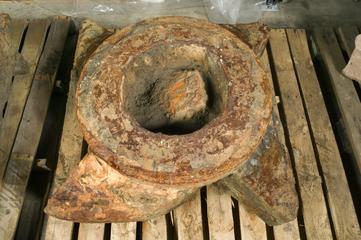
Model, of Woolf's Water Tube Boiler, 1819
- inventor:
- Arthur Woolf








Model of Woolf's water tube boiler after A. M. Heron de la Villefosse, De la Richesse Minerale, 1819, scale 1:8, patented 1803. Type built by J & E Hall of Dartford, Kent.
The ‘Elephant’ boiler was a form of water-tube boiler developed in the 1840s by Arthur Woolf, and often used in conjunction with his compound beam engine, which was then finding favour, particularly in France. It had two cylinders directly heated by the fire below a single central steam drum, which stored the steam generated in the two cylinders. The overall effect was to provide a large expanse of heating area between the fire and water, maximising the amount of heat which could generate steam, improving the boiler’s thermal efficiency and reducing the amount of fuel needed.




